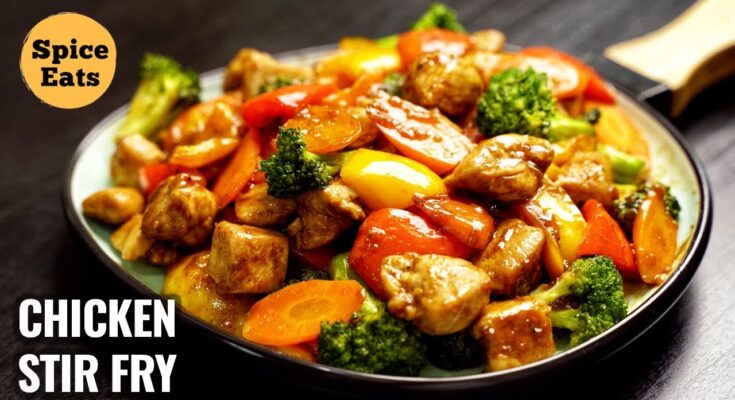Stir Fry Recipe: Do you love quick, flavorful meals that require minimal prep time? Stir-fry might just be your new best friend. Known for its lightning-fast cooking method and endless ingredient combinations, stir-fry is a go-to dish for busy weeknights and impromptu dinners. In this guide, we’ll walk you through everything you need to know about stir-frying, from selecting ingredients to perfecting your cooking technique. Let’s dive in!
What is Stir Fry?
Stir-frying is a traditional Chinese cooking method that involves cooking ingredients quickly over high heat while stirring continuously. This technique preserves the freshness of vegetables while creating beautifully caramelized proteins. Though stir-fry originated in China, it has become popular worldwide because of its versatility, speed, and healthy appeal. With just a few ingredients and minimal cooking equipment, you can whip up a delicious meal in minutes.
Ingredients Needed for a Basic Stir Fry
Proteins
You can choose your favorite protein:
- Chicken: Great for a lean and flavorful base.
- Beef: Provides a richer, deeper flavor.
- Shrimp: Cooks quickly and adds a seafood flair.
- Tofu: Perfect for vegetarians and absorbs sauce well.
Vegetables
Mix and match colorful vegetables to add crunch and nutrients:
- Bell peppers
- Broccoli
- Carrots
- Mushrooms
- Snap peas
Aromatics and Flavorings
- Garlic and ginger: Essential for adding depth to the dish.
- Scallions: Provide a light onion flavor.
- Chili: Adds heat if you like it spicy.
Sauce Options
- Soy sauce: A salty, umami base.
- Hoisin or oyster sauce: Adds sweetness and complexity.
- Teriyaki sauce: For a sweeter, more flavorful stir-fry.
Oils for Stir Frying
- Peanut oil: Has a high smoke point and adds a nutty flavor.
- Sesame oil: Used sparingly for its intense flavor.
- Vegetable oil: A neutral option for high-heat cooking.
Essential Equipment for Stir Frying
The right equipment can make all the difference. A wok is ideal because its shape helps heat distribute evenly, but a large skillet works too. You’ll also need a spatula or tongs to keep everything moving. High heat is crucial, so use a gas stove or a powerful electric burner if possible.
Prepping Your Ingredients
Cutting Proteins and Vegetables
Slice your ingredients into similar sizes to ensure they cook evenly. For proteins, thin slices cook faster, while vegetables should be chopped small enough to soften but large enough to maintain some crunch.
Marinating the Protein
For extra flavor, marinate your protein in soy sauce, ginger, garlic, and a dash of sesame oil. A 15-minute marinade is enough to boost taste.
Pre-cooking Starchy Ingredients
If you’re adding rice or noodles, cook them beforehand and cool them slightly to prevent sticking during stir-frying.
Step-by-Step Stir Fry Recipe
Step 1: Heat the Pan or Wok
Preheat your wok or skillet over high heat until it starts to lightly smoke. This ensures that your ingredients cook quickly without steaming.
Step 2: Add Oil and Aromatics
Add 1-2 tablespoons of oil and immediately toss in your garlic, ginger, or chili. Stir them for about 30 seconds to release their aroma.
Step 3: Add Proteins and Cook Until Browned
Add your marinated protein to the pan. Spread it out evenly and let it sear before stirring. Cook until browned, which usually takes 3-4 minutes.
Step 4: Add Vegetables
Add your vegetables in order of how long they take to cook—harder veggies like carrots go first, while softer ones like mushrooms go last.
Step 5: Add Sauce and Toss Everything Together
Pour your sauce over the ingredients and stir continuously to coat everything evenly. Cook for 1-2 minutes until the sauce thickens slightly.
Step 6: Finish with Garnishes
Top your stir-fry with sesame seeds, scallions, or fresh herbs for an extra burst of flavor.
Tips for the Perfect Stir Fry
- Don’t overcrowd the pan: Cook in batches if necessary.
- Use high heat: This ensures everything cooks quickly and retains flavor.
- Taste as you go: Adjust seasoning and sauces to your liking.
Common Mistakes to Avoid
- Overcooking the protein: Leads to dry and chewy meat.
- Using too much sauce: Can make the dish soggy.
- Not prepping ingredients: Stir-frying moves fast, so have everything ready before you start.
Variations of Stir Fry Recipes
- Vegan: Use tofu or tempeh instead of meat.
- Noodles: Swap rice with stir-fried noodles like lo mein.
- Regional Styles: Try Thai-style stir fry with fish sauce and basil.
Serving Suggestions
Serve your stir-fry with steamed rice, quinoa, or noodles. For an extra touch, pair it with spring rolls or a light salad.
Storing and Reheating Stir Fry
Store leftovers in an airtight container for up to 3 days. To reheat, use a pan over medium heat to maintain the texture.
FAQs about Stir Fry Recipe
1. What ingredients are essential for a stir fry?
Essential ingredients include protein (like chicken, beef, shrimp, or tofu), fresh vegetables (such as bell peppers, broccoli, and snap peas), aromatics (garlic, ginger), and a flavorful sauce made from soy sauce, sesame oil, and cornstarch.
2. What oil is best for stir frying?
Oils with high smoke points, such as vegetable oil, canola oil, or peanut oil, are ideal for stir frying because they withstand high heat without burning.
3. How do I keep vegetables crisp in a stir fry?
To keep veggies crisp, cook them quickly over high heat. Start with tougher vegetables like carrots or broccoli and add softer ones, such as bell peppers or zucchini, later in the cooking process.
4. What can I serve with stir fry?
Stir fry pairs perfectly with steamed rice, fried rice, or noodles like lo mein or soba. You can also enjoy it with quinoa or cauliflower rice for a healthier option.
5. How can I make my stir fry sauce thicker?
Use cornstarch or arrowroot powder mixed with water to thicken the sauce. Add the mixture during cooking and stir until the sauce reaches your desired consistency.
6. Can I make a stir fry in advance?
While stir fry is best enjoyed fresh, you can prepare ingredients in advance. Store sliced veggies, cooked rice, and sauce separately. Reheat quickly in a pan when ready to serve.
7. What’s the secret to a flavorful stir fry?
The secret lies in building flavors with aromatics (like garlic and ginger) and using a well-balanced sauce. Adding a splash of soy sauce or a dash of chili flakes at the end enhances the taste.
8. Can stir fry be made gluten-free?
Yes! Use tamari or gluten-free soy sauce, and ensure all other ingredients are certified gluten-free to make a gluten-free stir fry.
Conclusion
Mastering stir fry is all about striking the perfect balance between flavors, textures, and cooking techniques. With a little practice, you’ll find that stir fry can become your go-to dish for quick, delicious, and healthy meals. Whether you prefer savory chicken, vibrant vegetables, or plant-based proteins, the possibilities are endless.
Don’t hesitate to experiment with different ingredients! Try new sauces, seasonal vegetables, or even unique protein options to keep things exciting. The beauty of stir fry lies in its versatility—so have fun, explore new combinations, and make each meal uniquely yours.
References
For further reading and to validate the information provided in the Stir Fry Recipe with Post Links, explore these reputable sources:
- AllRecipes – A trusted platform offering a variety of stir fry recipes, cooking tips, and user reviews to inspire your culinary journey.
- Bon Appétit – Known for its chef-approved techniques, this site provides expert insights into creating flavorful and authentic stir fry dishes.
- Food Network – Features step-by-step guides and videos from renowned chefs to help you perfect your stir fry skills.
- BBC Good Food – A reliable resource for international stir fry recipes, emphasizing healthy and balanced meal options.
These sources provide deeper insights, alternative methods, and flavor variations to elevate your cooking experience.



